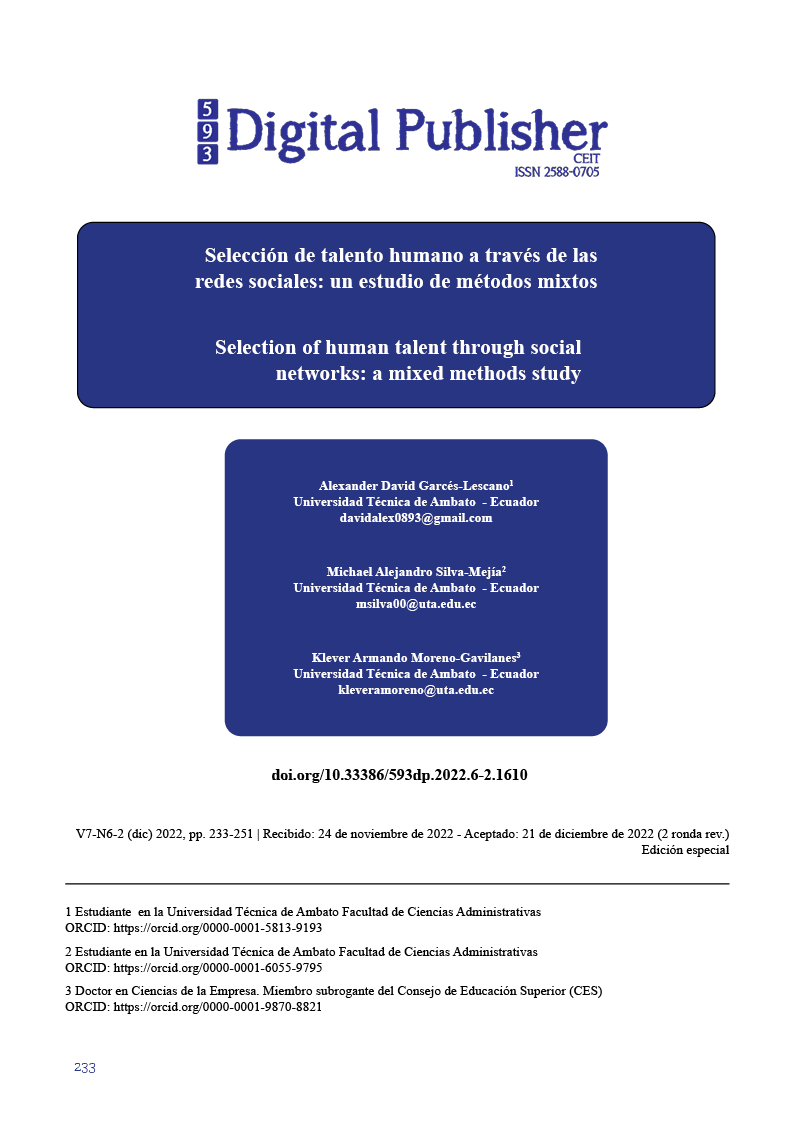Selection of human talent through social networks: a mixed methods study
Main Article Content
Abstract
The selection of personnel has been classified as a macro-process composed of several activities. From this point, the objective of the work was to analyze how human resources professionals use social platforms in hiring decisions during the different stages of the selection process. The research uses a mixed methods sequential explanatory approach. The first study consisted of a questionnaire-based survey of professional recruitment with the intention of describing various aspects of current practice (n = 429). The survey data were analyzed using descriptive and inferential statistics. The second study comprised semi-structured interviews with hiring professionals to provide a greater depth of analysis (n = 24). The data from the interviews were analyzed using a qualitative thematic analysis. The results revealed two types of users. Single-stage users emphasized efficiency concerns, while multi-stage users mentioned accessing profiles as needed. The evaluation of information from social platforms is not usually systematic, but some employers reported that they use scales, mainly in pre-selection.
Downloads
Article Details

This work is licensed under a Creative Commons Attribution-NonCommercial-ShareAlike 4.0 International License.
1. Derechos de autor
Las obras que se publican en 593 Digital Publisher CEIT están sujetas a los siguientes términos:
1.1. 593 Digital Publisher CEIT, conserva los derechos patrimoniales (copyright) de las obras publicadas, favorece y permite la reutilización de las mismas bajo la licencia Licencia Creative Commons 4.0 de Reconocimiento-NoComercial-CompartirIgual 4.0, por lo cual se pueden copiar, usar, difundir, transmitir y exponer públicamente, siempre que:
1.1.a. Se cite la autoría y fuente original de su publicación (revista, editorial, URL).
1.1.b. No se usen para fines comerciales u onerosos.
1.1.c. Se mencione la existencia y especificaciones de esta licencia de uso.
References
Alias, N. E., Noor, N. M., & Hassan, R. (2017). Examining the Mediating Effect of Employee Engagement on the Relationship between Talent Management Practices and Employee Retention in the Information and Technology (IT) Organizations in Malaysia. Journal of Human Resources Management and Labor Studies, 2(2), 227–242. https://doi.org/10.15640/jhrmls
Armijos, F., Bermúdez, A., & Mora, N. (2019). Gestión de administración de los recursos humanos. Universidad y Sociedad, 9(2), 313–318.
Astudillo, N., & Ortiz, M. (2016). La tecnología en la gestión del talento humano en las instituciones púlicas del ecuador. Observatorio de La Economia Latinoamericana, 1–16.
Bahamón, C., Cortés, V., Piñeros, D., & Rojas, O. (2014). Evolución de la gestión del talento humano, su interacción con la ética, los valores intrínsecos del líder del área, su rol con los grupos de interés y su impacto estratégico en la cultura organizacional, en empresas de los diferentes sectores de Bogotá. In Institucional Sergio Arboleda.
Bell, R., Espin, M., & Espin, E. (2015). Tendencias de la gestión de talento humano en el sector público. Revista Científica ECOCIENCIA, 2(2), 1–14.
Bravo, W., Delgado, B., & Parrales, C. (2016). Análisis de las investigaciones sobre Talento Humano. Revista Publicando, 3(7), 354–365.
Cadena, J. (2016). La administración del talento humano en las empresas del sector público. Ciencias Económicas y Empresariales, 2, 448–460.
Calderón, G. (2004). Gerencia del talento humano en el sector público: análisis en entidades públicas de Manizales, Pereira y Armenia. Cuadernos de Administración, 17(28), 71–90.
Chiavenato, I. (2011). Administración de recursos humanos. El capital humano en las organizaciones (J. M. Chacón, Ed.; Novena). McGraw Hill.
Cunalata, A. (2019). “Gestión del talento humano y sus efectos en el desempeño laboral en la empresa boho, Ambato” proyecto.
Flores, S. (2015). Modelo estratégico de gestión de talento humano para la superintendencia de economía popular y solidaria.
Hernández-Sampieri, R., Fernández-Collado, C., & Lucio, P. B. (2014). Metodología de la Investigación. In M. Toledo (Ed.), Animal Genetics (Sexta). McGraw Hill.
Kwon, W. J. (2014). Human Capital Risk and Talent Management Issues in the Insurance Market: Public Policy, Industry and Collegiate Education Perspectives. The International Association for the Study of Insurance Economics, 39(14), 173–196. https://doi.org/10.1057/gpp.2013.11
Lester, D., Tudor, K., Loyd, D., & Mitchell, T. (2012). Marketing Mavens’ Fusion with Social Media Marketing Mavens’ Fusion with Social Media. Atlantic Marketing Journal, 1(1), 79–94.
Licandro, O., Yapor, S., & Correa, P. (2021). Beneficios del Voluntariado Corporativo para la gestión de los Recursos Humanos. Revista Venezolana de Gerencia, 26(93), 227–244. https://doi.org/10.52080/rvg93.16
Muñoz, L. (2015). Análisis del desarrollo de la Gestión del Talento Humano y la incidencia en el desempeño laboral del personal administrativo del Hospital del IESS de Babahoyo.
Peralta, H. O. (2015). Gestión del talento humano y su relación con el desempeño laboral del personal de la municipalidad distrital de Pacucha - Andahuaylas – Apurímac, 2014.
Reyes, A., & Gonzalez, L. (2014). Gestión estratégica del talento humano consideraciones de juicio para el desarrollo eficiente de proyectos. Suma de Negocios, 5(11), 49–61. https://doi.org/10.1016/S2215-910X(14)70019-9
Rojas, R., & Vilchez, S. (2018). Gestión del talento humano y su relacion con el desempeño laboral del personal del puesto de salud sagrado corazón de Jesús-Lima, enero 2018. Universidad Norbr Wiener, 94.
Romero, A., Ortiz, L., & Barrazueta, K. (2017). Análisis de la administración del talento humano en el centro de educación básica fisco-misional “cristo rey” de la ciudad de esmeraldas. 11(1), 92–105.
Samantha, V., Espinoza, V., & Chavarria, A. (2017). Importancia de la Gestión del Talento Humano como Estrategia para la Atracción y Retención de Docentes en las Organizaciones Educativas de Ecuador The importance of Human Talent Management as a Strategy for Attracting and Retaining Teachers in Educational. 145–168.
Soto, F. (2006). La gestión de recursos humanos en las organizaciones de servicio. Laurus, 12, 19.
Vallejo, L. (2016). Gestión del talento humano ESPOCH 2016. 133.
Vallejo, S., & Portalanza, A. (2017). Importancia de la gestión del talento humano como estrategia para la atracción y retención de docentes en las organizaciones educativas de Ecuador. Uees, 145–168.
Vallejo, V., & Portalanza, A. (2017). Importancia de la Gestión del Talento Humano como Estrategia para la Atracción y Retención de Docentes en las Organizaciones Educativas de Ecuador The importance of Human Talent Management as a Strategy for Attracting and Retaining Teachers in Educational. PODIUM, Edición es, 145–168.
Wang, R., & Huang, Y. (2018). Communicating corporate social responsibility (CSR) on social media: How do message source and types of CSR messages influence stakeholders’ perceptions? Corporate Communications, 23(3), 326–341. https://doi.org/10.1108/CCIJ-07-2017-0067




